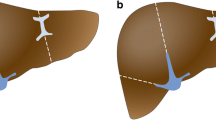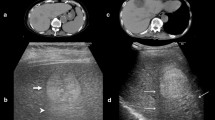Abstract
Objectives
To investigate the performance of the Liver Imaging Reporting and Data System (LI-RADS) v2017 for combined hepatocellular cholangiocarcinoma (cHCC-CCA) in the differential diagnosis from hepatocellular carcinoma (HCC) and prediction of prognosis on gadoxetic acid-enhanced MRI (Gd-EOB-MRI).
Methods
Patients at high risk of HCC with pathologically confirmed cHCC-CCAs (n = 70) and a matched control of HCCs (n = 70) who had undergone Gd-EOB-MRI were included. LI-RADS category was assigned for each lesion by two radiologists. Imaging features and surgical outcomes were compared between cHCC-CCAs of LR-M and LR-5/4 using the χ2 test or Fisher’s exact test. Recurrence-free survival (RFS) was estimated using Kaplan–Meier survival curves and compared using the log-rank test.
Results
cHCC-CCAs and HCCs were categorised as LR-M, LR-5/4 and LR-TIV in 61.4% (43/70), 37.1% (26/70) and 1.4% (1/70) and 10.0% (7/70), 88.6% (62/70) and 1.4% (1/70), respectively. cHCC-CCAs of LR-5/4, in comparison to LR-M, showed significantly higher frequencies of major HCC features: arterial hyperenhancement (96.2% (25/26) vs. 58.1% (25/43), p = 0.001), washout appearance (80.8% (21/26) vs. 48.8% (21/43), p = 0.011) and enhancing capsule (34.6% (9/26) vs. 11.6% (5/43), p = 0.031). After curative surgery, patients with cHCC-CCAs of LR-M showed a higher early recurrence rate (≤ 6 months) than did those with LR-5/4 (27.8% (10/36) vs. 4.8% (1/21), p = 0.041), whereas no significant difference was observed in RFS (log-rank p = 0.084).
Conclusions
By using LI-RADS on Gd-EOB-MRI, a substantial proportion of cHCC-CCAs can be categorised as non-LR-M. In addition, cHCC-CCAs mimicking HCCs on imaging (LR-5/4) may indicate better surgical outcomes with regard to early recurrence than those of LR-M.
Key Points
• cHCC-CCAs can be categorised as either LR-M or non-LR-M on Gd-EOB-MRI.
• cHCC-CCAs of LR-5/4 frequently demonstrate major HCC imaging features.
• LI-RADS categorisation may provide prognostic information after surgery in cHCC-CCAs.




Similar content being viewed by others
Abbreviations
- cHCC-CCA:
-
Combined hepatocellular cholangiocarcinoma
- Gd-EOB-MRI:
-
Gadoxetic acid-enhanced magnetic resonance imaging
- LI-RADS:
-
Liver Imaging Reporting and Data System
- LR-4:
-
Probably HCC
- LR-5:
-
Definitely HCC
- LR-M:
-
Probably or definitely malignant, not HCC specific
- RFS:
-
Recurrence-free survival
References
Sapisochin G, Fidelman N, Roberts JP, Yao FY (2011) Mixed hepatocellular cholangiocarcinoma and intrahepatic cholangiocarcinoma in patients undergoing transplantation for hepatocellular carcinoma. Liver Transpl 17:934–942
Yin X, Zhang BH, Qiu SJ et al (2012) Combined hepatocellular carcinoma and cholangiocarcinoma: clinical features, treatment modalities, and prognosis. Ann Surg Oncol 19:2869–2876
Garancini M, Goffredo P, Pagni F et al (2014) Combined hepatocellular-cholangiocarcinoma: a population-level analysis of an uncommon primary liver tumor. Liver Transpl 20:952–959
Joo I, Kim H, Lee JM (2015) Cancer stem cells in primary liver cancers: pathological concepts and imaging findings. Korean J Radiol 16:50–68
Shetty AS, Fowler KJ, Brunt EM, Agarwal S, Narra VR, Menias CO (2014) Combined hepatocellular-cholangiocarcinoma: what the radiologist needs to know about biphenotypic liver carcinoma. Abdom Imaging 39:310–322
Potretzke TA, Tan BR, Doyle MB, Brunt EM, Heiken JP, Fowler KJ (2016) Imaging features of biphenotypic primary liver carcinoma (hepatocholangiocarcinoma) and the potential to mimic hepatocellular carcinoma: LI-RADS analysis of CT and MRI features in 61 cases. AJR Am J Roentgenol 207:25–31
Jung DH, Hwang S, Song GW et al (2017) Longterm prognosis of combined hepatocellular carcinoma-cholangiocarcinoma following liver transplantation and resection. Liver Transpl 23:330–341
Gera S, Ettel M, Acosta-Gonzalez G, Xu R (2017) Clinical features, histology, and histogenesis of combined hepatocellular-cholangiocarcinoma. World J Hepatol 9:300–309
Elsayes KM, Hooker JC, Agrons MM et al (2017) 2017 version of LI-RADS for CT and MR imaging: an update. Radiographics 37:1994–2017
Mitchell DG, Bruix J, Sherman M, Sirlin CB (2015) LI-RADS (Liver Imaging Reporting and Data System): summary, discussion, and consensus of the LI-RADS Management Working Group and future directions. Hepatology 61:1056–1065
Shah A, Tang A, Santillan C, Sirlin C (2016) Cirrhotic liver: what's that nodule? The LI-RADS approach. J Magn Reson Imaging 43:281–294
Joo I, Lee JM, Lee SM, Lee JS, Park JY, Han JK (2016) Diagnostic accuracy of Liver Imaging Reporting and Data System (LI-RADS) v2014 for intrahepatic mass-forming cholangiocarcinomas in patients with chronic liver disease on gadoxetic acid-enhanced MRI. J Magn Reson Imaging 44:1330–1338
Fraum TJ, Tsai R, Rohe E et al (2018) Differentiation of hepatocellular carcinoma from other hepatic malignancies in patients at risk: diagnostic performance of the Liver Imaging Reporting and Data System Version 2014. Radiology 286:158–172
Horvat N, Nikolovski I, Long N et al (2017) Imaging features of hepatocellular carcinoma compared to intrahepatic cholangiocarcinoma and combined tumor on MRI using Liver Imaging and Data System (LI-RADS) version 2014. Abdom Radiol (NY). https://doi.org/10.1007/s00261-017-1261-x
Fowler KJ, Sheybani A, Parker RA 3rd et al (2013) Combined hepatocellular and cholangiocarcinoma (biphenotypic) tumors: imaging features and diagnostic accuracy of contrast-enhanced CT and MRI. AJR Am J Roentgenol 201:332–339
Fujita N, Nishie A, Kubo Y et al (2015) Hepatocellular carcinoma: clinical significance of signal heterogeneity in the hepatobiliary phase of gadoxetic acid-enhanced MR imaging. Eur Radiol 25:211–220
Nam JG, Lee JM, Joo I et al (2017) Intrahepatic mass-forming cholangiocarcinoma: relationship between computed tomography characteristics and histological subtypes. J Comput Assist Tomogr. https://doi.org/10.1097/rct.0000000000000695
An C, Park S, Chung YE et al (2017) Curative resection of single primary hepatic malignancy: Liver Imaging Reporting and Data System category LR-M portends a worse prognosis. AJR Am J Roentgenol 209:576–583
Park SH, Lee SS, Yu E et al (2016) Combined hepatocellular-cholangiocarcinoma: gadoxetic acid-enhanced MRI findings correlated with pathologic features and prognosis. J Magn Reson Imaging. https://doi.org/10.1002/jmri.25568
Sasaki M, Sato H, Kakuda Y, Sato Y, Choi JH, Nakanuma Y (2015) Clinicopathological significance of 'subtypes with stem-cell feature' in combined hepatocellular-cholangiocarcinoma. Liver Int 35:1024–1035
Tang A, Bashir MR, Corwin MT et al (2017) Evidence supporting LI-RADS major features for CT- and MR imaging-based diagnosis of hepatocellular carcinoma: a systematic review. Radiology. https://doi.org/10.1148/radiol.2017170554:170554
Fowler KJ, Tang A, Santillan C et al (2018) Interreader reliability of LI-RADS version 2014 algorithm and imaging features for diagnosis of hepatocellular carcinoma: a large international multireader study. Radiology 286:173–185
Cruite I, Tang A, Sirlin CB (2013) Imaging-based diagnostic systems for hepatocellular carcinoma. AJR Am J Roentgenol 201:41–55
Itoh S, Ikegami T, Yoshizumi T et al (2015) Long-term outcome of living-donor liver transplantation for combined hepatocellular-cholangiocarcinoma. Anticancer Res 35:2475–2476
Sapisochin G, de Lope CR, Gastaca M et al (2014) Intrahepatic cholangiocarcinoma or mixed hepatocellular-cholangiocarcinoma in patients undergoing liver transplantation: a Spanish matched cohort multicenter study. Ann Surg 259:944–952
Chang CC, Chen YJ, Huang TH et al (2017) Living donor liver transplantation for combined hepatocellular carcinoma and cholangiocarcinoma: experience of a single center. Ann Transplant 22:115–120
Magistri P, Tarantino G, Serra V, Guidetti C, Ballarin R, Di Benedetto F (2017) Liver transplantation and combined hepatocellular-cholangiocarcinoma: feasibility and outcomes. Dig Liver Dis 49:467–470
Wu CH, Yong CC, Liew EH et al (2016) Combined hepatocellular carcinoma and cholangiocarcinoma: diagnosis and prognosis after resection or transplantation. Transplant Proc 48:1100–1104
Funding
The authors state that this work has not received any funding.
Author information
Authors and Affiliations
Corresponding author
Ethics declarations
Guarantor
The scientific guarantor of this publication is Ijin Joo.
Conflict of interest
The authors of this manuscript declare no relationships with any companies whose products or services may be related to the subject matter of the article.
Statistics and biometry
No complex statistical methods were necessary for this paper.
Informed consent
Written informed consent was waived by the institutional review board.
Ethical approval
This retrospective study performed at one institution was approved by the Institutional Review Board of Seoul National University Hospital.
Methodology
• retrospective
• case-control study
• performed at one institution
Electronic supplementary material
ESM 1
(DOCX 64 kb)
Rights and permissions
About this article
Cite this article
Jeon, S.K., Joo, I., Lee, D.H. et al. Combined hepatocellular cholangiocarcinoma: LI-RADS v2017 categorisation for differential diagnosis and prognostication on gadoxetic acid-enhanced MR imaging. Eur Radiol 29, 373–382 (2019). https://doi.org/10.1007/s00330-018-5605-x
Received:
Revised:
Accepted:
Published:
Issue Date:
DOI: https://doi.org/10.1007/s00330-018-5605-x




